Effects of Interdependence and Social Interaction-Based Person-Team Fit
Abstract
:1. Introduction
2. Conceptualizing Person-Team Fit
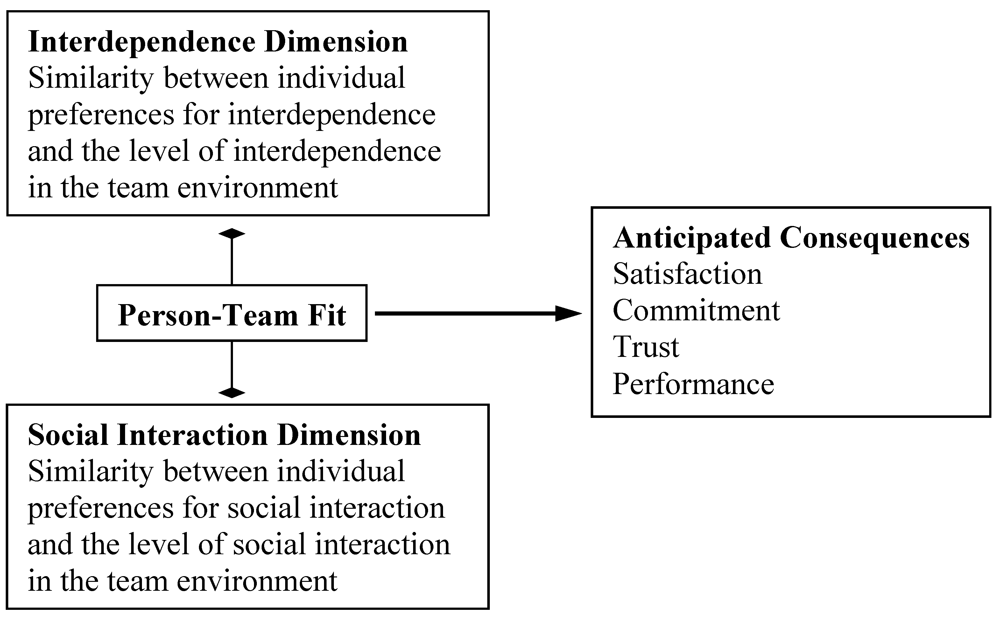
2.1. Interdependence in Team Environments
2.2. Social Interaction in Team Environments
3. Consequences of Person-Team Fit
Hypothesis 1: Person-team fit will be positively related to satisfaction in the team.
Hypothesis 2: Person-team fit will be positively related to commitment to the team.
Hypothesis 3: Person-team fit will be positively related to trust in the team.
Hypothesis 4: Person-team fit will be positively related to individual performance.
4. Method
4.1. Sample
4.2. Measures
5. Results
| Mean | SD | 1 | 2 | 3 | 4 | 5 | 6 | 7 | 8 | 9 | 10 | |
| Dependent Variables | ||||||||||||
| 1. Satisfaction in the team | 3.97 | .70 | ||||||||||
| 2. Commitment to the team | 3.78 | .64 | .72** | |||||||||
| 3. Trust in the team | 3.99 | .53 | .66** | .64** | ||||||||
| 4. Self-rated performance | 4.10 | .50 | .26** | .32** | .20** | |||||||
| Preferences and Environment | ||||||||||||
| 5. Pref. for interdependence | 3.14 | .50 | .12 | .27** | .21** | .00 | ||||||
| 6. Interdependence environ. | 3.28 | .53 | .28** | .40** | .23** | .10 | .40** | |||||
| 7. Pref. for social interaction | 3.94 | .63 | .19** | .34** | .34** | .08 | .56** | .29** | ||||
| 8. Social interaction environ. | 3.88 | .55 | .20** | .38** | .35** | .12 | .45** | .55** | .62** | |||
| Interaction Terms | ||||||||||||
| 9. Interaction 5 x 6 | 10.43 | 2.85 | .25** | .41** | .27** | .07 | .84** | .82** | .51** | .59** | ||
| 10. Interaction 7 x 8 | 15.50 | 4.04 | .24** | .42** | .41** | .14* | .57** | .47** | .91** | .88** | .62** | |
| Control Variable | ||||||||||||
| 11. Team Tenure | 2.51 | 3.56 | .16* | .27** | .16* | .08 | .08 | .14* | .05 | .08 | .14* | .08 |
| DV = Satisfaction in the Team (H1) | DV = Commitment to the Team (H2) | |||||
| Independent Variable | Step 1 | Step 2 | Step 3 | Step 1 | Step 2 | Step 3 |
| Team tenure | .16* | .12 | .12 | .27** | .21** | .20** |
| Interdependence preferences | –.09 | –.12 | –.01 | –.01 | ||
| Interdependence environment | .26** | .25** | .26** | .23** | ||
| Social interaction preferences | .17 | .18 | .19* | .22* | ||
| Social interaction environment | -.01 | .02 | .12 | .16 | ||
| Interdependence interaction term | .16* | .04 | ||||
| Social Interaction interaction term | .08 | .18** | ||||
| Δ R2 | .03 | .09 | .04 | .07 | .19 | .03 |
| Δ F | 5.51* | 5.00** | 4.18* | 16.06** | 13.33** | 4.73** |
| Adjusted R2 | .02 | .09 | .12 | .07 | .25 | .27 |
| DV = Team Trust (H3) | DV = Self-rated Performance (H4) | |||||
| Independent Variable | Step 1 | Step 2 | Step 3 | Step 1 | Step 2 | Step 3 |
| Team tenure | .16* | .13 | .11 | .08 | .07 | .05 |
| Interdependence preferences | –.03 | –.02 | –.11 | –.13 | ||
| Social interaction preferences | .05 | .02 | .06 | .02 | ||
| Interdependence environment | .21* | .25** | .06 | .10 | ||
| Social interaction environment | .20* | .25** | .10 | .16 | ||
| Interdependence interaction term | .01 | .12 | ||||
| Social Interaction interaction term | .24** | .23** | ||||
| Δ R2 | .03 | .14 | .05 | .01 | .02 | .08 |
| Δ F | 5.36* | 8.53** | 6.63** | 1.33 | 1.16 | 8.51** |
| Adjusted R2 | .02 | .15 | .19 | .00 | .01 | .07 |
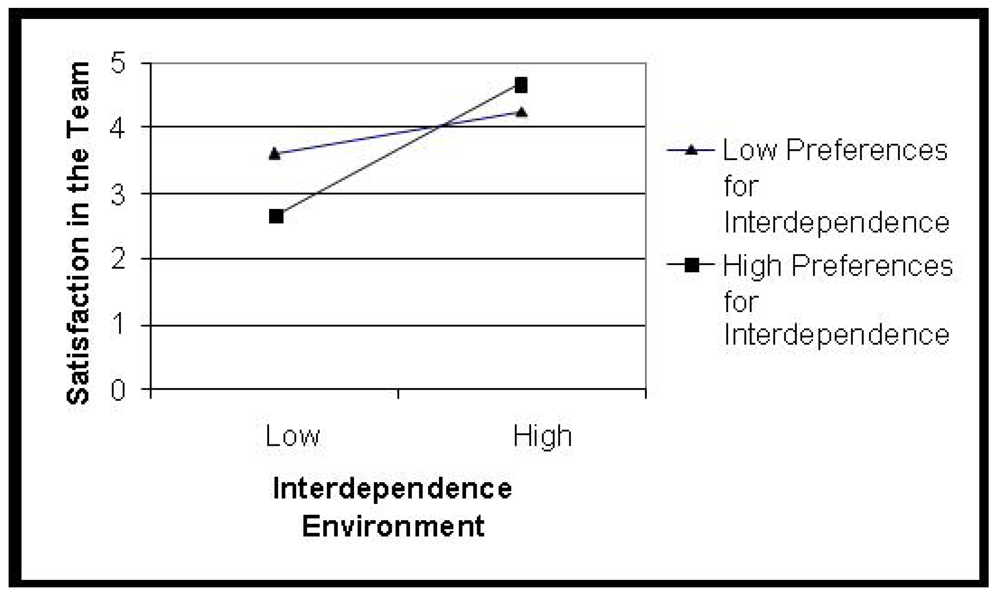
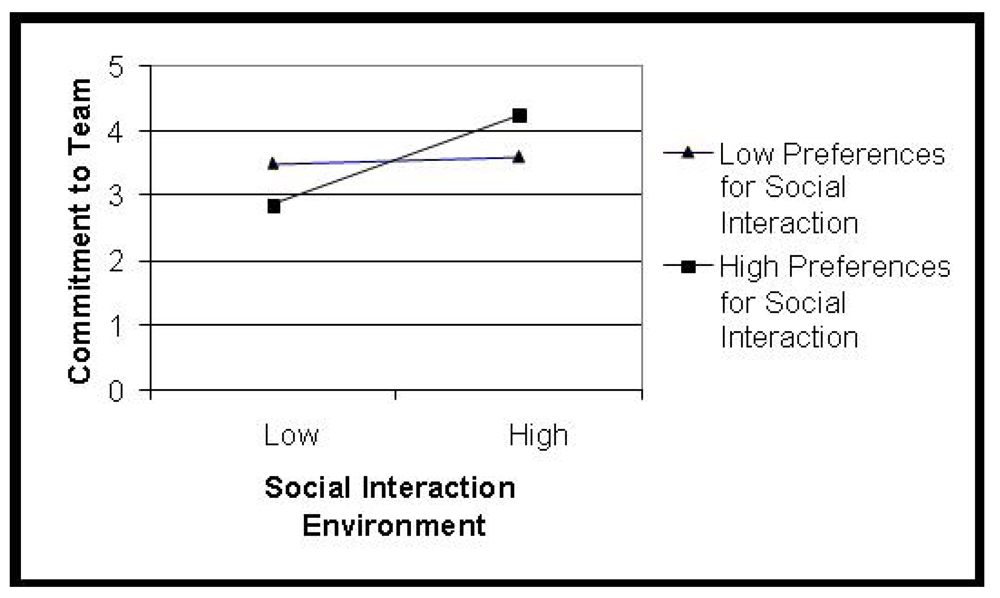
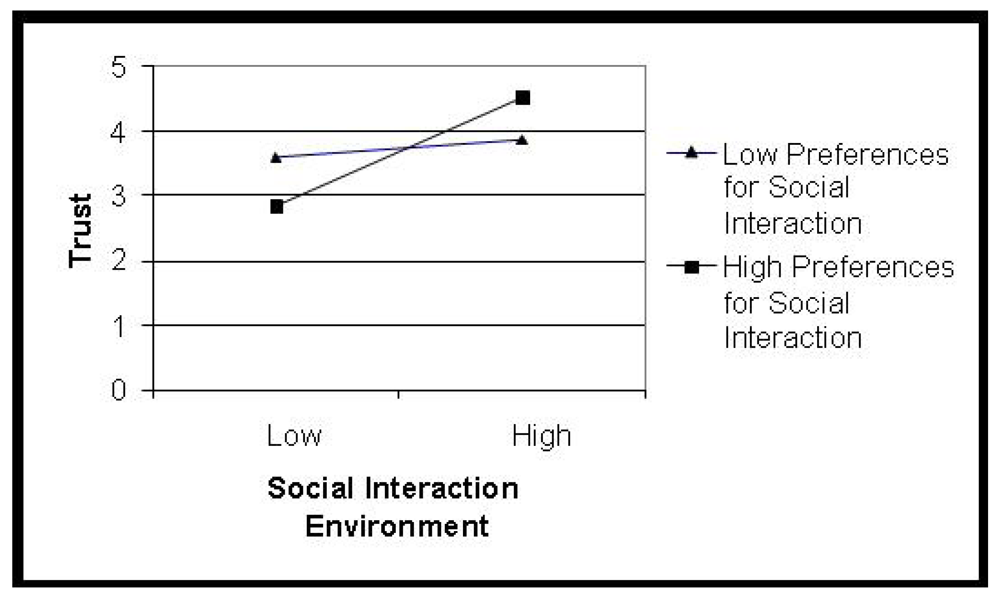
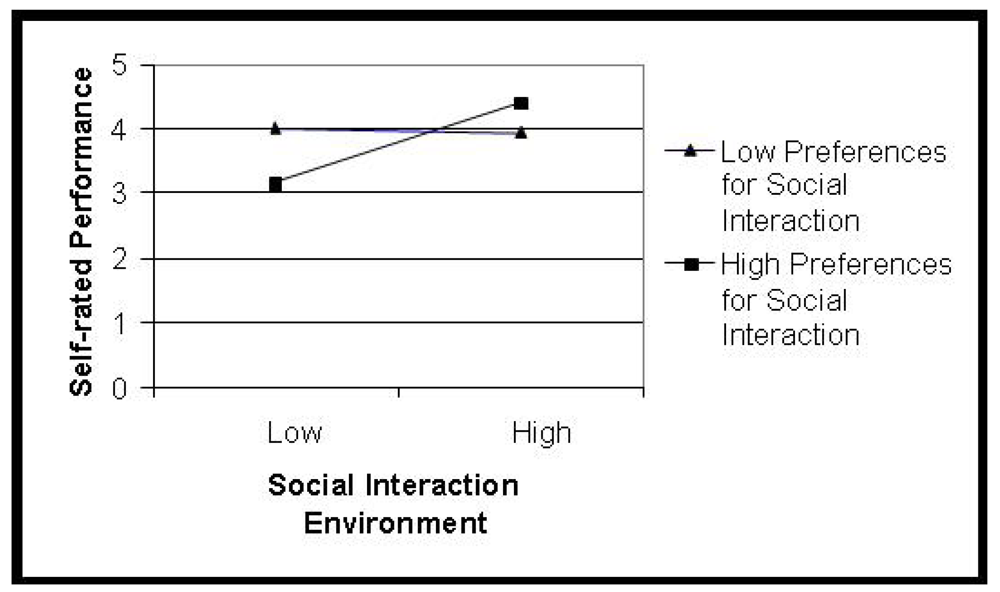
6. Discussion
6.1. Strengths and Limitations
6.2. Implications for Future Research
6.3. Implications for Leaders and Managers
Appendix A
| Preferences for Interdependence | Interdependence Environment | ||
| I prefer that feedback about how well I am doing my job come primarily from information about how well the entire team is doing. | .45 | Feedback about how well I am doing my job comes primarily from information about how well the entire team is doing. | .46 |
| I prefer that most of my activities be related to team goals rather than to individual goals. | .51 | I do very few activities on my job that are not related to the goals of my team. | .40 |
| I like my performance evaluation to reflect my own performance, not my team’s performance. (reverse scored) | .47 | My performance evaluation is not influenced by how well my team performs. (reverse scored) | .63 |
| I like my work goals to come directly from the goals of my team. | .53 | In my work, individual goals are considered more important than team goals. (reverse scored) | .39 |
| I like work where everyone must do his or her part to finish the job. | .43 | My work is not done until everyone in my team has done his or her part. | .49 |
| I like the rewards I receive from my job (for example, pay, promotion, etc.) to be based on my individual performance, not the team’s performance. (reverse scored) | .42 | The rewards I receive from my job (for example, pay, promotion, etc.) are based on my individual performance, not the team’s performance. (reverse scored) | .43 |
| To me, individual goals are more important than team goals. (reverse scored) | .40 | My work goals come directly from the goals of my team. | .47 |
Appendix B
| Preferences for Social Interaction | Social Interaction Environment | ||
| To me, working with a team is better than working alone. | .89 | In my job, working with a team is considered better than working alone. | .63 |
| I prefer to work with others in a team rather than working alone. | .79 | I do my work with others in the team rather than working alone. | .71 |
| Given the choice, I would rather do a job where I can work alone than do a job where I have to work with others in a team. (reverse scored) | .67 | I can do my job in this team alone rather than working with other team members. (reverse scored) | .66 |
| I prefer a job that allows me to work closely with other people. | .60 | I work closely with other people on my job. | .62 |
Acknowledgements
References
- O’Toole, J.; Lawler, E.E., III. The New American Workplace; Palgrave Macmillan: New York, NY, USA, 2006. [Google Scholar]
- Lewin, K. Dynamic Theory of Personality; McGraw-Hill: New York, NY, USA, 1935. [Google Scholar]
- Schneider, B. Interactional psychology and organizational behavior. In Research in Organizational Behavior; Staw, B.M., Cummings, L.L., Eds.; JAI Press: Greenwich, CT, USA, 1983; Volume 5, pp. 1–31. [Google Scholar]
- Kristof-Brown, A.L.; Zimmerman, R.D.; Johnson, E.C. Consequences of individuals’ fit at work: A meta-analysis of person-job, person-organization, person-group, and person-supervisor fit. Pers. Psychol. 2005, 58, 281–342. [Google Scholar] [CrossRef]
- French, J.R.P.; Rogers, W., Jr.; Cobb, S. Adjustment as person-environment fit. In Coping and Adaptation; Coelho, G.V., Hamburg, D.A., Adams, J.E., Eds.; Basic Books: New York, NY, USA, 1974; pp. 316–333. [Google Scholar]
- Holland, J.L. Making Vocational Choices: A Theory of Careers; Prentice-Hall: Englewood Cliffs, NJ, USA, 1985. [Google Scholar]
- Edwards, J.R. Person-job fit: A conceptual integration, literature review, and methodological critique. In International Review of Industrial and Organizational Psychology; Cooper, C.L., Robertson, I.T., Eds.; John Wiley & Sons Ltd: New York, NY, USA, 1991; Volume 6, pp. 283–357. [Google Scholar]
- Kristof, A.L. Person-organization fit: An integrative review of its conceptualizations, measurement, and implications. Pers. Psychol. 1996, 49, 1–49. [Google Scholar] [CrossRef]
- Witt, L.A. Enhancing goal congruence: A solution to organizational politics. J. Appl. Psychol. 1998, 83, 666–674. [Google Scholar] [CrossRef]
- Werbel, J.D.; Johnson, D.J. The use of person-group fit for employment selection: A missing link in person-environment fit. Hum. Resour. Manage. 2001, 40, 227–240. [Google Scholar] [CrossRef]
- Ferris, G.R.; Youngblood, S.A.; Yates, V.L. Personality, training performance, and withdrawal: A test of the person-group fit hypothesis for organizational newcomers. J. Vocat. Behav. 1985, 27, 377–388. [Google Scholar] [CrossRef]
- Vancouver, J.B.; Millsap, R.E.; Peters, P.A. Multilevel analysis of organizational goal congruence. J. Appl. Psychol. 1994, 79, 666–679. [Google Scholar] [CrossRef]
- Adkins, C.L.; Ravlin, E.C.; Meglino, B.M. Value congruence between co-workers and its relationship to work outcomes. Group Organ. Manage. 1996, 21, 439–460. [Google Scholar] [CrossRef]
- Kristof-Brown, A.L.; Stevens, C.K. Goal congruence in project teams: Does the fit between members’ personal mastery and performance goals matter? J. Appl. Psychol. 2001, 86, 1083–1095. [Google Scholar] [CrossRef]
- Hollenbeck, J.R.; Moon, H.; Ellis, A.P.J.; West, B.J.; Ilgen, D.R.; Sheppard, L.; Porter, C.O.L.H.; Wagner, J.A., III. Structural contingency theory and individual differences: Examination of external and internal person-team fit. J. Appl. Psychol. 2002, 87, 599–606. [Google Scholar] [CrossRef]
- Burch, G.St.J.; Anderson, N. Measuring person-team fit: Development and validation of the team selection inventory. J. Manage. Psychol. 2004, 19, 406–426. [Google Scholar] [CrossRef]
- Adkins, B.; Caldwell, D. Firm or subgroup culture: Where does fitting in matter most? J. Organ. Behav. 2004, 25, 969–978. [Google Scholar] [CrossRef]
- Hollenbeck, J.R. A structural approach to external and internal person-team fit. Appl. Psychol. Int. Rev. 2000, 49, 534–549. [Google Scholar]
- DeRue, D.S.; Morgeson, F.P. Stability and change in person-team and person-role fit over time: The effects of growth satisfaction, performance, and general self-efficacy. J. Appl. Psychol. 2007, 92, 1242–1253. [Google Scholar] [CrossRef]
- Hackman, J.R. The design of work teams. In Handbook of Organizational Behavior; Lorsch, J.W., Ed.; Prentice-Hall, Inc.: Englewood Cliffs, NJ, USA, 1987. [Google Scholar]
- Conway, T.L.; Vickers, R.R.; French, J.R.P., Jr. An application of person-environment fit theory: Perceived versus desired control. J. Soc. Issues 1992, 48, 95–107. [Google Scholar]
- Saavedra, R.; Early, P.C.; Van Dyne, L. Complex interdependence in task-performing groups. J. Appl. Psychol. 1993, 78, 61–72. [Google Scholar]
- Cheng, J.L.C. Interdependence and coordination in organizations: A role-system analysis. Acad. Manage. J. 1983, 26, 156–162. [Google Scholar] [CrossRef]
- Thompson, J.D. Organizations in Action; McGraw-Hill: New York, NY, USA, 1967. [Google Scholar]
- Shea, G.P.; Guzzo, R.A. Groups as human resources. In Research in Personnel and Human Resources Management; Rowland, K., Ferris, G., Eds.; JAI Press: Greenwich, CT, USA, 1987; Volume 5, pp. 323–356. [Google Scholar]
- Van Vijfeijken, H.; Kleingeld, A.; Van Tuijl, H.; Algera, J.A.; Thierry, H. Interdependence and fit in team performance management. Pers. Rev. 2006, 35, 98–117. [Google Scholar] [CrossRef]
- Schneider, B. E = f(P,B): The road to a radical approach to person-environment fit. J. Vocat. Behav. 1987, 31, 222–230. [Google Scholar] [CrossRef]
- Wagner, J.A. Studies of individualism-collectivism: Concept and measure. Group Organ. Stud. 1995, 11, 280–303. [Google Scholar] [CrossRef]
- McClelland, D.C. Human Motivation; Scott Foresman: Glenview, IL, USA, 1985. [Google Scholar]
- Steers, R.M.; Braunstein, D.N. A behaviorally-based measure of manifest needs in work settings. J. Vocat. Behav. 1976, 9, 251–266. [Google Scholar] [CrossRef]
- Cheek, J.M.; Buss, A.H. Shyness and sociability. J. Pers. Soc. Psychol. 1981, 41, 330–339. [Google Scholar] [CrossRef]
- Locke, E.A. The nature and causes of job satisfaction. In Handbook of Industrial and Organizational Psychology; Dunnette, M., Ed.; Rand McNally: Chicago, IL, USA, 1976; pp. 1297–1350. [Google Scholar]
- Fishbein, M.; Ajzen, I. Belief, Attitude, Intention, and Behavior: An Introduction to Theory and Research; Addison-Wesley: Reading, MA, USA, 1975. [Google Scholar]
- Mowday, R.; Steers, R.; Porter, L. Organizational Linkages: The Psychology of Commitment, Absenteeism, and Turnover; Academic Press: New York, NY, USA, 1979. [Google Scholar]
- O’Reilly, C.A., III.; Chatman, J.; Caldwell, D.F. People and organizational culture: A profile comparison approach to assessing person-organization fit. Acad. Manage. J. 1991, 34, 487–516. [Google Scholar] [CrossRef]
- Morris, J.H.; Steers, R.M. Structural influences in organizational commitment. J. Vocat. Behav. 1980, 17, 50–57. [Google Scholar] [CrossRef]
- Lewis, J.; Weigert, A. Trust as a social reality. Soc. Forces 1985, 63, 967–985. [Google Scholar]
- Mayer, R.C.; Davis, J.H.; Schoorman, F.D. An integrative model of organizational trust. Acad. Manage. Rev. 1995, 20, 709–734. [Google Scholar]
- Dirks, K.T. The effects of interpersonal trust on work group performance. J. Appl. Psychol. 1999, 84, 445–455. [Google Scholar] [CrossRef]
- Ravlin, E.C.; Ritchie, C.M. Perceived and actual organizational fit: Multiple influences on attitudes. J. Manage. Issues 2006, 18, 175–192. [Google Scholar]
- O’Reilly, C.A., III.; Chatman, J. Organizational commitment and psychological attachment: The effects of compliance, identification, and internalization of prosocial behavior. J. Appl. Psychol. 1986, 71, 492–499. [Google Scholar] [CrossRef]
- Chatman, J.A. Improving interactional organizational research: A model of person-organization fit. Acad. Manage. Rev. 1989, 14, 333–349. [Google Scholar]
- Goodman, S.A.; Svyantek, D.J. Person-organization fit and contextual performance: Do shared values matter? J. Vocat. Behav. 1999, 55, 254–275. [Google Scholar] [CrossRef]
- Elfenbein, H.A.; O’Reilly, C.A., III. Fitting in: The effects of relational demography and person-culture fit on group process and performance. Group Organ. Manage. 2007, 32, 109–142. [Google Scholar] [CrossRef]
- Campion, M.A.; Papper, E.M.; Medsker, G.J. Relations between work group characteristics and effectiveness: A replication and extension. Pers. Psychol. 1996, 49, 429–452. [Google Scholar] [CrossRef]
- Bretz, R.D.; Judge, T.A. Person-organization fit and the theory of work adjustment: Implications for satisfaction, tenure, and career success. J. Vocat. Behav. 1994, 44, 32–54. [Google Scholar] [CrossRef]
- Wageman, R. Interdependence and group effectiveness. Admin. Sci. Quart. 1995, 40, 145–180. [Google Scholar] [CrossRef]
- Edwards, A.L. Edwards Personal Preference Schedule; The Psychological Corporation: New York, NY, USA, 1953. [Google Scholar]
- Jackson, D.N. Personality Research Form Manual; Research Psychologists Press, Inc.: Foshen, NY, USA, 1974. [Google Scholar]
- Pearce, J.L.; Gregersen, H.B. Task interdependence and extrarole behavior: A test of the mediating effects of felt responsibility. J. Appl. Psychol. 1991, 76, 838–844. [Google Scholar] [CrossRef]
- Caplan, R.D. Person-environment fit theory and organizations: Commensurate dimensions, time perspectives, and mechanisms. J. Vocat. Behav. 1987, 31, 248–267. [Google Scholar] [CrossRef]
- Mayer, R.C.; Davis, J.H. The effect of the performance appraisal system on trust for management: A field quasi-experiment. J. Appl. Psychol. 1999, 84, 123–136. [Google Scholar] [CrossRef]
- Kaiser, H.F. An index of factorial simplicity. Psychometrika 1974, 39, 31–36. [Google Scholar] [CrossRef]
- Stewart, D.W. The application and misapplication of factor analysis in marketing research. J. Marketing Res. 1981, 18, 51–62. [Google Scholar] [CrossRef]
- Kivimaki, M.; Kuk, G.; Elovainio, M.; Thomson, L.; Kalliomaki-Levanto, T.; Heikkila, A. The Team Climate Inventory (TCI)—Four or five factors? Testing the structure of TCI in samples of low and high complexity jobs. J. Occup. Organ. Psych. 1997, 70, 375–390. [Google Scholar] [CrossRef]
- Mishra, D.P.; Heide, J.B.; Cort, S.G. Information asymmetry and levels of agency relationships. J. Marketing Res. 1998, 35, 277–296. [Google Scholar] [CrossRef]
- Bedeian, A.G.; Ferris, G.R.; Kacmar, K.M. Age, tenure, and job satisfaction: A tale of two perspectives. J. Vocat. Behav. 1992, 40, 33–48. [Google Scholar] [CrossRef]
- Aiken, L.S.; West, S.G. Multiple Regression: Testing and Interpreting Interactions; Sage: Newbury Park, CA, USA, 1991. [Google Scholar]
- Venkatraman, N. The concept of fit in strategy research: Toward verbal and statistical correspondence. Acad. Manage. Rev. 1989, 14, 423–444. [Google Scholar]
- Meyer, J.P.; Irving, P.G.; Allen, N.J. Examination of the combined effects of work values and early work experiences on organizational commitment. J. Organ. Behav. 1998, 19, 29–52. [Google Scholar] [CrossRef]
- Puccio, G.J.; Talbot, R.J.; Joniak, A.J. Person-environment fit: Examining the use of commensurate scales. Psychol. Rep. 1995, 76, 931–938. [Google Scholar] [CrossRef]
- Sutton, G.; Griffin, M.A. Integrating expectations, experiences, and psychological contract violations: A longitudinal study of new professionals. J. Occup. Organ. Psych. 2004, 77, 493–514. [Google Scholar] [CrossRef]
- Cohen, J.; Cohen, P. Applied Multiple Regression/Correlation Analysis for the Behavioral Sciences, 2nd ed; Lawrence Erlbaum Associates: Hillsdale, NJ, USA, 1983. [Google Scholar]
- Podsakoff, P.M.; Organ, D.W. Self-reports in organizational research: Problems and prospects. J. Manage. 1986, 12, 531–544. [Google Scholar] [CrossRef]
- Kristof-Brown, A.L.; Colbert, A.E.; Jansen, K.J. A policy-capturing study of the simultaneous effects of fit with jobs, groups and organizations. J. Appl. Psychol. 2002, 87, 985–993. [Google Scholar] [CrossRef]
- Molleman, E.; Nauta, A.; Jehn, K.A. Person-job fit applied to teamwork: A multilevel approach. Small Gr. Res. 2004, 35, 515–539. [Google Scholar] [CrossRef]
- Shin, Y. A person-environment fit model for virtual organizations. J. Manage. 2004, 30, 725–743. [Google Scholar]
- Schneider, B.; Goldstein, H.W.; Smith, D.B. The ASA framework: An update. Pers. Psychol. 1995, 48, 747–773. [Google Scholar] [CrossRef]
- Gully, S.M.; Incalcaterra, K.A.; Joshi, A.; Beaubieu, J.M. A meta-analysis of team-efficacy, potency, and performance: Interdependence and level of analysis as moderators of observed relationships. J. Appl. Psychol. 2002, 87, 819–832. [Google Scholar] [CrossRef]
- Kalleberg, A.L. The mismatched worker: When people don’t fit their jobs. Acad. Manage. Perspect. 2008, 22, 24–40. [Google Scholar] [CrossRef]
- Werbel, J.D.; DeMarie, S.M. Aligning strategic human resource management and person-environment fit. Hum. Resour. Manage. R. 2005, 15, 247–262. [Google Scholar] [CrossRef]
© 2012 by the authors; licensee MDPI, Basel, Switzerland. This article is an open-access article distributed under the terms and conditions of the Creative Commons Attribution license (http://creativecommons.org/licenses/by/3.0/).
Share and Cite
Glew, D.J. Effects of Interdependence and Social Interaction-Based Person-Team Fit. Adm. Sci. 2012, 2, 26-46. https://doi.org/10.3390/admsci2010026
Glew DJ. Effects of Interdependence and Social Interaction-Based Person-Team Fit. Administrative Sciences. 2012; 2(1):26-46. https://doi.org/10.3390/admsci2010026
Chicago/Turabian StyleGlew, David J. 2012. "Effects of Interdependence and Social Interaction-Based Person-Team Fit" Administrative Sciences 2, no. 1: 26-46. https://doi.org/10.3390/admsci2010026
APA StyleGlew, D. J. (2012). Effects of Interdependence and Social Interaction-Based Person-Team Fit. Administrative Sciences, 2(1), 26-46. https://doi.org/10.3390/admsci2010026




